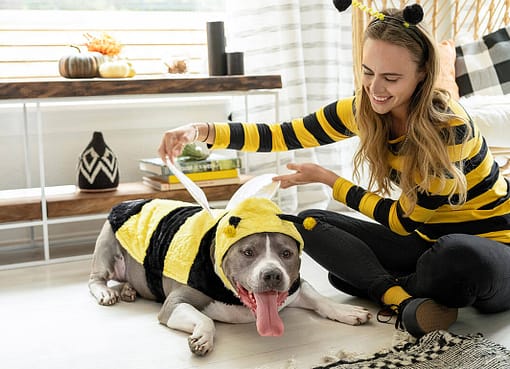For most of this summer, we’ve been focused on low-water landscaping and xeriscaping, but summer is also a good time to do pest management. Pests are going to be looking for places to avoid the heat, just like you. Inside your house is a great place to do that. According to CV Lawn King, if you want to reduce your pest problem, there are ways you can manage your lawn to discourage them.
Types of Pests In Your Yard
1. Ticks and Fleas
Ticks and fleas are nasty pests that spread disease everywhere they go. You might not think of this as a lawn problem, but it can be. While pets are usually seen as the culprits, they aren’t the only ones. Squirrels, mice, and other animals spread them as well. If you have them in your yard, there’s a good chance they may drop off their unwanted passengers on your lawn. Keeping an eye out for them is important, so you should treat your lawn early for them.
also read: 4 Landscaping Ideas That Don’t Need Water
2. Grubs
Easily the most common pest to run into, grubs of various kinds feed on the roots of your grass. If you don’t treat your lawn for them, then you’ll find patches of your grass dying in the heat of summer. This is another issue you’ll want to tackle early on. There are plenty of pest control products that specifically target them.
also read: How to Dress Up Your Dog Safely
3. Mosquitos
You wouldn’t think your lawn is a big concern to mosquitos, but how you manage your lawn can affect how often you deal with them. Like ticks and fleas, these insects will spread diseases, some of which can be potentially fatal.
also read: How to Protect Your Garden During the Winter
4. Box Elder Bugs
A big problem in Cache Valley, box elder bugs are fairly harmless in most senses, but extremely annoying. They reproduce very quickly, produce a terrible smell when startled, and poop on everything. They can also bite if antagonized. Though not a health risk, the bite does leave a red lump. The biggest problem with them is that if killed, their bodies attract beetles. Beetle grubs will kill your lawn, as previously mentioned.
also read: 5 Benefits of Taking Online Gardening Classes
5. Yellow Jackets
These wasps are ground nesting. They are predatory, so they won’t do serious damage to your lawn, but as they are highly aggressive to anything going near their nest, you don’t want them around. Even if you’re not allergic to their stings, they hurt like hell.
You’ll want to consult a professional exterminator for these pests, as you want to properly identify them. Too many people have mistaken honeybees for wasps, and while nobody will miss the wasps, honeybees are valuable pollinators.
also read: Christmas Ideas for Decorating With Outdoor Flags
How to Protect Against Pests
1. Don’t Overwater Your Lawn
Overwatering your lawn can potentially create standing water. Any place that’s regularly in the shade and has even slightly lower elevation than the rest of your yard can create puddles that will stick around long enough for mosquitoes to lay eggs in them. If you find standing water forming puddles anywhere on your property, takes steps to correct the problem so they don’t form.
Even if you don’t get puddles of standing water, fleas and ticks love wet grass, as it’s much cooler than the surrounding temperature.
2. Build Barriers
You can use different plants to create natural barriers against pest insects. For example, the citronella plant produces an oil responsible for a lemony scent that repels mosquitos. Chrysanthemums repels box elder bugs as well as many other pests and is even used to make an environmentally friendly insect repellent.
Keep in mind that many of these plants may require more water than others, so you’ll want to group these together – preferably around your house – in order to centralize the areas of your lawn that get watered more. This will help reduce your water bill.
And if you’re using mulch as a replacement for grass in some areas, cedar mulch has been proven to repel fleas. Set cedar mulch barriers around places your children and pets play to scare off the fleas.
3. Use Pest Control Treatments
There are plenty of lawn treatments are designed to kill pests. Many mix with fertilizer, so you’ll want to apply these in late spring, when the hatching cycle for most insects start. This will prevent the infestations from taking root and also keep your lawn from growing too much for the hot season. Other treatments may be specifically for these pests at different times through the summer to target specific types of bugs.
4. Dethatch Your Lawn and Keep It Trimmed
Thick thatch and really tall grass provides a lot of cover for ticks, fleas, and mosquitos. They love to hide in this stuff during the middle of the day and if you have an overgrown lawn, you’ll just be encouraging them to come to your home. You need to grow your lawn a little longer in the summer to give the soil cover from the heat, but never let it grow longer than 3 to 3.5 inches.
5. Prune Trees and Bushes
When trees and bushes are left to their own business, they tend to grow thick branches to block out the sun. This is a survival strategy in nature, as the lack of sunlight will keep weeds from growing around them. The problem is that many pest insects love the shade. The thicker the branches, the more attractive the ground beneath will be. Prune your trees and bushes so that some sunlight streams through to send them packing.
6. Keep Out Critters
I know squirrels are cute, but it’s a potential health hazard. If you’ve got mice, squirrels, and other small mammals in your yard, encourage them to keep their distance. If you have a cat, that’ll usually do the trick. Deer can also spread ticks and fleas, so do what you can to scare them away when they come around.
also read: Choose the Right Fencing Materials For Project
Spiders Aren’t Pests
Learn to love arachnids. I know, we’re all a bit scared of them. I myself used to be phobic about them, but other, more serious pests have helped me make piece with my 8-legged friends. The biggest fear of spiders is their venom, but very few species produce venom capable of harming humans. Even then, most spiders won’t bite unless you go out of your way to provoke them. Naturally, you want to keep them out of your house, as they might crawl into your bed and then bite, accidentally or on purpose, if you roll over on them while you sleep. Otherwise, let spiders do as they please. They will gladly help you with many of your pest problems.
And if the spiders are jumping spiders, you can even let them in the house. They will jump away from you as soon as you get near, so they do not bite people, but will do a real number on other pests in your house. They especially love mosquitos.
Also, they’re adorable
Get Rid of Pests
These are just some of the pests you find in your lawn. The best time to treat for pests is when they hatch, which ranges from mid-April to early September, depending on the species. If you haven’t been treating your lawn for pests already, you should get on it soon. If you leave the problem over the winter, you’ll just be giving the specimens more time to build up their infestation. Check with local lawn care and pest control to find out what you should be treating for and when. It won’t just keep your lawn in good health, it will keep you in good health, too.












Comment here